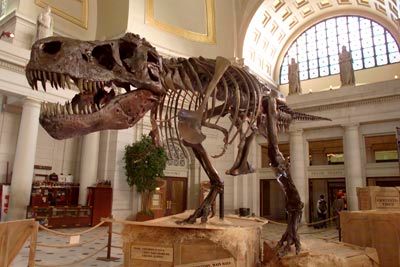The 1993 movie "Jurassic Park" wasn't the first film to show dinosaurs in the modern world. But it did a good job of bringing the idea of cloning dinosaurs into popular culture. It portrayed dinosaur cloning in a way that made sense to a lot of people, and it was a blockbuster, making more than $900 million worldwide [source: New York Times].
Dinosaur Image Gallery
Advertisement
"Jurassic Park" built on the idea of extracting DNA from the bellies of mosquitoes preserved in amber. While this might seem possible at first glance, it's highly unlikely that scientists could find usable dinosaur DNA in mosquito fossils. Scientists would need a very specific specimen -- a female mosquito that had consumed lots of dinosaur blood immediately before landing in tree resin. Since fossilization in amber is a relatively rare event, the chances of this happening are pretty small.
The lack of possible specimens isn't the only problem. Most insect fossils found in amber are also too young to contain dinosaur blood -- dinosaurs were extinct by the time the insects became trapped. Many insects decay from the inside out after they're trapped, leaving nothing inside for scientists to try to extract. Finally, the sample would have to be very dry, since DNA can break down quickly in the presence of water.
But if researchers did find a perfectly preserved mosquito with a body full of dinosaur blood, retrieving its DNA would still be difficult. The blood with the dinosaur DNA would be surrounded by the body of an insect, which has its own DNA. There could also be DNA from other cells trapped in the amber, which could contaminate the sample. Then, of course, there's the DNA in the laboratory itself -- and in the body of the scientist doing the extraction.
The fictional scientists in "Jurassic Park" try to get around these difficulties by combining dinosaur DNA with frog DNA. But this would be like trying to assemble a jigsaw puzzle using billions of pieces that come from two different puzzles. Plus, frogs might not be the best candidates for providing replacement DNA. Today, one of the most prevalent theories about the fate of the dinosaurs is that some evolved into birds, not frogs.
On top of all that, the most common form of cloning used on animals today involves nuclear transfer. Scientists put the nucleus of one cell into a second cell of the same species after destroying the second cell's nucleus. There are no dinosaur cells or dinosaur eggs that could host new set of DNA. Researchers would have to find a different way to let the DNA grow into a living dinosaur.
So the "Jurassic Park" method is out -- but are there other ways to bring dinosaurs to life? Read on to explore the possible answers.
Advertisement


